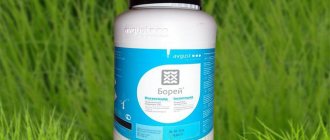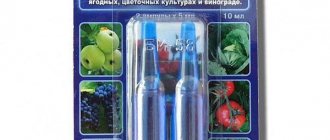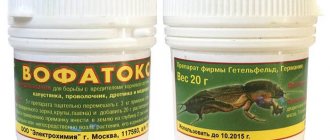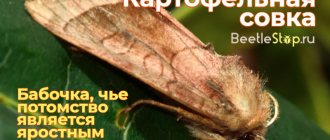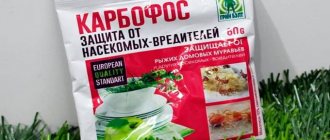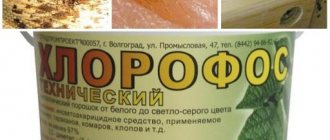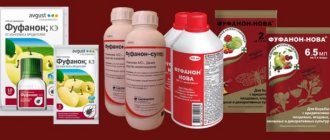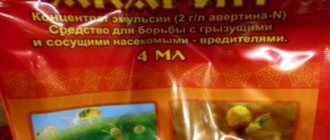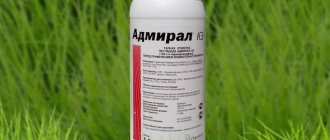Description
Borei is available in the form of a concentrated emulsion. To obtain a working solution, the required amount of concentrate is dissolved in cold water. The ratio of insecticide to water depends on the type of crop and the type of pest. The product is sold in 1 liter plastic bottles.
Borey insecticide, dosed in accordance with the instructions for use, is not dangerous to humans. However, in any concentration it is toxic to bees, fish and amphibians.
The effectiveness of Borei is ensured by two active ingredients:
- Imidocloprid (150 g/liter) . It has a systemic effect. Penetrating into the stems, roots and leaves of plants, it provides long-term protection against pests.
- Lambda-cyhalothrin (50 g/liter) . Forms a protective layer on the outside. It acts instantly, causing paralysis of the respiratory and motor functions of the insect. Insect death occurs within 24 hours after treatment.
The principle of action is expressed in the suppression of the transmission of nerve impulses through the central nervous system of insects. The action occurs immediately after the insect comes into contact with the drug. Sensitivity occurs when the drug, when sprayed, enters the chitinous cover of pests and feeds on and inside the sprayed plant. The drug kills adults and their larvae at all stages of development. One application is enough to completely destroy an insect colony. During the season, 1-2 procedures are performed.
Boreas' protective functions extend to the most important crops:
| Culture, object | Pest | Consumption rate of the drug, l/ha |
| Wheat | pest bug, aphids, bread beetles, wheat thrips, bread flea beetles, | 0,08-0,1 |
| 0.1(A) | ||
| Barley | Pjavitsa, Swedish flies, stem sawflies, wheat thrips, aphids | 0,08-0,1 |
| Rape | Sacral flea beetles, rapeseed flower beetle, rapeseed sawfly, crypted beetle | 0,08-0,1 |
| Sugar beet | beet flea beetles, weevils, aphids, meadow moth | 0,1-0,12 |
| Pastures, areas infested with locusts, wild vegetation | Locusts | 0,1-0,15 |
| 0.1(A) | ||
| Peas, vegetable peas | Pea weevil, pea codling moth, aphid | 0,12-0,15 |
| Potatoes, tomato | Colorado beetle | 0,08-0,12 |
| Onion | Onion flies | 0,2-0,25 |
| Carrot | carrot fly | 0,2 |
| carrot psyllid | 0,12-0,14 | |
| Cabbage | Cabbage cutworm, cabbage and turnip whites, cabbage moth, rump flea beetle, cabbage aphid | 0,1-0,14 |
| Apple tree | Codling moths, leaf rollers | 0,3 |
| Grape | Leaf rollers | 0,3 |
The manufacturer also produces a three-component insecticide “ Borey Neo ” with a similar principle of action. In this case, lambda-cyhalothrin is replaced by two active substances: alpha-cypermethrin and clothianidin. The drug does not reduce its effectiveness in hot weather and high humidity. First of all, the instructions for using the Borey Neo insecticide suggest using it to protect grains and potatoes.
The result is immediate: the larvae die within a few minutes, and the adults within a maximum of 24 hours. Within 5 days after spraying, destroy the entire population of potato beetles on the site.
Spectrum of action
Major pests of several important crops:
- On grains - pest bug, leech, aphids, bread beetles, thrips, flea beetles, cicadas, stem sawflies, bread flies.
- On rapeseed there are sacral flea beetles, rapeseed flower beetle, rapeseed sawfly, and crypted proboscis.
- On beets there are beet flea beetles, weevils, aphids, and meadow moths.
- In pastures and other areas inhabited by Locusts, Borea can be used to destroy them. In addition, the drug is effective against a complex of gnawing and sucking pests of peas (including vegetables), potatoes, tomatoes, onions, carrots, cabbage, apple trees, and grapes.
Hazard Class
Borei belongs to hazard class 3 (conditionally safe chemical substance) and hazard class 2 for persistence in soil .
Rate and symptoms of exposure
A few minutes after administration of the drug, the pests stop feeding and die within 24 hours.
Spectrum of action
The product is used to protect and control pests of cereals, fruit trees, vegetables and vineyards. For potatoes it is used as an effective remedy against the Colorado potato beetle. The components that make up the drug Borey contribute to the death of such dangerous insects as fleas, aphids, thrips, bedbugs, flies and moths. The effectiveness of the application is due to the action of 2 components:
- imidacloprid (150 g/l) penetrates plant tissue and prolongs the protective function of the drug up to 28 days after treatment;
- Lambda-cyhalothrin (50 g/l) causes a rapid paralytic effect. The death of insects occurs within 24 hours from the moment of contact with the insecticide.
Ask and receive useful advice from professional gardeners and experienced summer residents.>>
In addition, lambda-cyhalothrin is not destroyed by exposure to sunlight and inhibits the growth of larvae. These properties allow the drug to successfully fight pests at different stages of development and destroy secretly living insects.
The manufacturer also produces a three-component insecticide Borey Neo, which has a similar effect on pests. Instead of lambda-cyhalothrin, the product contains the pyrethroid alpha-cypermethrin and the neonicotinoid clothianidin. Borey Neo is mainly intended for the protection of cereals and potatoes. Retains protective functions not only at high temperatures, but also at high air humidity.
Advantages of the drug
The Borey insecticide is used both on farmland and on individual farms. The composition and form of release of the drug provide a number of advantages:
- ease of use of a concentrated suspension;
- wide coverage of processed crops;
- a wide range of pests for the destruction of which insecticide is used;
- fast and long-lasting action after a single treatment;
- low degree of toxicity to humans;
- compatibility in tank mixtures with other drugs;
- photostability and heat resistance.
It is advisable to use Borei in case of significant spread of pests or during spring preventive treatment of an orchard. The high toxicity of the active ingredients for bees and water inhabitants imposes restrictions on the use of the insecticide. The cost of a concentrated suspension (from 3400 rubles/l) is also one of the few disadvantages of the drug Borey.
Composition and release form
This insecticide is produced in the form of a well-known concentrated suspension. The pesticide contains 2 active ingredients: imidacloprid 150 g per 1 l and lambda-cyhalothrin 50 g per 1 l. The drug is available in 1 liter bottles.
Active substance
Imidacloprid belongs to the class of neonicotinoids and exhibits systemic, contact and intestinal activity against many types of biting and sucking pests.
Lambda-cyhalothrin is a synthetic pyrethroid; it has contact-intestinal activity, but unlike the vast majority of pyrethroids, it is also effective against herbivorous mites.
Mechanism of operation
Imidacloprid, from the class of neonicotinoids, has systemic activity; the substance penetrates through leaf and stem surfaces and through roots, affects the central nervous system of pests, blocking the functioning of nerve fibers. Lambda-cyhalothrin, from the class of synthetic pyrethroids, remains on the leaf surface, but is effective not only against insects, but also against phytophagous mites.
“Borey” inhibits the transmission of nerve impulses, insects are destroyed both when the solution comes into contact with them, and as a result of eating the sprayed plants. Double action allows the product to confidently destroy insects that are located on the lower surface of foliage and in hard-to-reach places.
Expert opinion
Zarechny Maxim Valerievich
Agronomist with 12 years of experience. Our best country expert.
Ask a Question
The action of the insecticide begins almost immediately after the pests appear in the body; they cannot feed and die within 1 day. "Borey" protects plants for 2-3 weeks.
Application
Boreas destroys populations of pests resistant to pyrethroids and organophosphorus compounds. The drug combines rapid action (knockdown effect) with a long period of protective action. Retains high insecticidal activity in hot weather and with prolonged exposure to intense sunlight. The quality of treatment is comparable to Titus herbicide.
Application temperature
When applying insecticides to plants or soil, it is important to remember to take into account weather conditions and adhere to the temperature indicated on the package.
The optimal temperature for treating plants with insecticides is 12-22°C. At lower or higher temperatures, the effectiveness of insecticides is significantly reduced. However, some pyrethroid insecticides can be applied when air temperatures reach 7°C. In any case, always carefully read the temperature specification on the packaging.
pros
The main advantages of this drug
- has high efficiency;
- protects not only the surface of plants, but also their tissues;
- long period of protection;
- begins to affect pests very quickly;
- not washed away by precipitation; retains its strength under the scorching rays of the sun;
- consists of substances that differ in their mechanism of action;
- with the help of Boreas you can control the insect population when growing grain crops;
- destroys hidden parasites that settle on the underside of leaves;
- possibility of spraying using aviation.
What pests does it help with?
Borei is used to destroy pests on open ground crops. The insecticide is used to control potatoes, root crops, grain crops, as well as fruit trees and grapes.
Using Boreas is effective against:
- Colorado potato beetle;
- all types of locusts;
- aphids;
- onion, carrot flies;
- psyllids;
- codling moths;
- cruciferous flea beetles;
- thrips;
- scoop;
- drinkers;
- stem sawflies;
- weevils;
- meadow moth.
The drug has a rapid effect on insects. The pests stop feeding within one hour and die within 24 hours. The drug has a detrimental effect on adults and larvae.
From the Colorado potato beetle
Boreas from the Colorado potato beetle is a modern broad-spectrum insecticide. It kills adults and larvae of different ages. It retains its toxic properties for approximately 28 days. It does not affect vegetation and, when used correctly, does not harm the environment.
Before use, prepare a solution by dissolving the required amount of concentrate in cold water. The finished product has a slightly specific smell. Treatment of potatoes, tomatoes, and eggplants against the Colorado potato beetle is carried out by spraying. The drug is low toxic to humans, lethal to bees, amphibians and fish.
After processing plants, Boreas accumulates in leaves, stems, and partly in root crops. It takes 2 hours for complete absorption. The effectiveness of the drug is not affected by sunlight or unpleasant rains, but the poison gradually breaks down and is completely neutralized in 28 days.
The drug enters the insect's body through the intestinal contact route. Active ingredients disrupt the functioning of the nervous system. Within minutes, paralysis and death occur. The larvae die almost immediately if the poison gets on the chitinous shells during spraying.
When working with insecticides, wear rubber gloves, a respirator, long sleeves and a sweatshirt. Contact with skin causes irritation, allergic reactions, penetration into the respiratory tract can cause poisoning of varying severity. Early symptoms include headache, weakness, dizziness, nausea, vomiting, abdominal discomfort and diarrhea.
Spectrum and mechanism of action
"Rakurs" is used to treat the following diseases:
- all types of rust;
- net spot;
- anthracnose;
- cercospora;
- powdery mildew and other fungal diseases;
- Alternaria blight.
Cyprocnazole has a protective and healing effect on plants. Thanks to it, the chemical dissolves well in water. Quickly penetrates the leaves (half an hour after treatment). After which it moves through all parts of the plant.
Epoxiconazole has a preventive effect. After spraying, it quickly penetrates into plant tissue through the leaves and mixes with other parts. The benefits of this substance include activity in both cold and warm weather.
The preparation also contains specific polymers, which, due to their action, ensure that drops of the solution “stick” to the sheet. After treatment, the solution completely penetrates into all tissues of the treated plants within 2 hours.
Consumption rate
| Culture, object | Pests | Consumption rate, l/ha |
| Wheat | Bugs, aphids, bread beetles, wheat thrips, bread flea beetles, | 0,08-0,1 |
| 0.1(A) | ||
| Barley | Whiteflies, Swedish flies, whiteflies, wheat thrips, aphids | 0,08-0,1 |
| Rape | Cruciferous flea beetles, rapeseed beetle, rapeseed flea beetle, cotton moth | 0,08-0,1 |
| Sugar beet | Beet flea beetle, beetles, aphids, meadow moth | 0,1-0,12 |
| Pastures, locust infested areas, wild vegetation | Locust | 0,1-0,15 |
| 0.1(A) | ||
| Peas, Vegetable peas | Pea weed, pea moth, aphid | 0,12-0,15 |
| Potatoes, tomatoes | Colorado beetle | 0,08-0,12 |
| Onion | Onion fly | 0,2-0,25 |
| Carrot | carrot fly | 0,2 |
| Carrot leaf fly | 0,12-0,14 | |
| Cabbage | Cabbage whitefly, cabbage and rapeseed whitefly, cabbage leaf moth, cruciferous flea beetle, cabbage aphid | 0,1-0,14 |
| Apple tree | Fruit moth, leaf beetle | 0,3 |
| Grape | Butterflies | 0,3 |
Dosage
To spray one hundred square meters of potato plantation, you need 0.8-1.2 ml of Boreas or 1-1.5 ml of Boreas Neo. This amount of insecticide should be dissolved in 4 liters of water. Treatment should be carried out in dry, windless weather, early in the morning or late in the evening. It is recommended that after spraying there is no rain for at least 6 hours.
A few minutes after contact with the solution of drops or poisoning with tops soaked in imidacloprid, insects become paralyzed, stop feeding and die within 24 hours. The manufacturer recommends using the products even in areas where pests have developed resistance to organophosphorus or pyrethroid insecticides.
It is allowed to spray 1 or 2 areas with the preparations per season. The interval between spraying is at least 20 days. Potatoes can be eaten no earlier than 3 weeks after treatment.
Hot weather and drought do not reduce the effectiveness of the drug. If the recommended doses are observed, insecticides are not only harmless to crops, but also increase their resistance to stress.
The prepared solution must be used immediately; it cannot be stored. It is allowed to spray tomatoes, beets, carrots, and onions with its residue.
Insecticide "Borey"
No matter how hard we try to grow vegetables and fruits on our plot without the use of chemicals, sooner or later we will have to turn to it. When it comes to fertilizers, sometimes homemade organic matter works quite well.
But it is difficult to cope with the invasion of pests or the spread of diseases without the help of the chemical industry. In particular, this applies to insecticides: sometimes it is difficult to preserve the crop without their participation.
Below we will talk about the insecticide “Borey” and its use.
Application of insecticide "Borey"
The main difference between this drug is in its work: there are two substances at once, completely different in terms of their effect on pests. First, it completely blocks the ability to send signals through the central nervous system in insects. Then, immediately after contact, the pest dies, regardless of whether it fell on the leaf during spraying or after treatment.
But, like any good and powerful drug, the Borey insecticide has one feature regarding its consumption rate. The fact is that the product is incredibly toxic, so it will have to be used strictly according to the instructions and without the slightest excess of doses, in addition, it should be noted that:
- The insecticide "Borey" is very dangerous for bees. You will have to take this point into account and notify all apiary owners in the area. For this reason, it is allowed to treat the area only in the early morning or late evening. Bee owners usually know all the intricacies of this matter, so all you have to do is notify them in advance.
- The situation is the same with nearby fisheries.
Now a little more detail regarding the dosage of the Borey insecticide. In general recommendations, the consumption per hectare of land is 200-400 liters. When working with a vineyard and orchard, these standards are higher and here you will need 800-1500 liters. The consumption rate of the Borey insecticide when working with seedlings is no more than 200 liters.
Instructions for using the Borey insecticide for potatoes
The familiar Colorado potato beetle will remain out of work if this drug is used in time. We will spray the plantings during the growing season.
According to the instructions for using the Borey insecticide, we will use it for potatoes in the general recommended quantities, namely 200-400 liters. This chemical will also work well against potato bugs.
If you have early varieties, spraying is carried out twice with an interval of up to twenty days. For late varieties, the number of treatments is up to four.
| Greenhouses made of arcs with covering material Greenhouses or compact greenhouses are a sure way to speed up the harvest by two to three weeks. More and more summer residents are thinking about building similar structures on their site. In our article we will talk about the simplest type of greenhouse - from arches with covering material. | Having created a bed of cucumbers on your site, do not forget to worry not only about watering and weeding, but also about protecting the plants from pests. Otherwise, a good harvest is akin to a lottery - you'll be lucky or unlucky. Read about the main pests of cucumbers in the article. |
| Pests of tomatoes in a greenhouse Greenhouse gardening is very popular, especially in northern regions where it is not possible to grow heat-loving crops in open ground. However, vegetables in greenhouses are often affected by pests. Read the article about pests of tomatoes in a greenhouse. | Caterpillars on tomatoes in a greenhouseVegetables grown in greenhouses - tomatoes, peppers, cabbage - are often attacked by insect pests, the larvae of which accumulate in the soil from year to year. We will tell you in this article what to do if you notice caterpillars on tomatoes in a greenhouse. |
Instructions for use on how to breed Borei
When stored, the drug loses its protective properties within 5-10 hours. Therefore, the working solution is prepared immediately before spraying. First, a liquid concentrate is obtained from the suspension, for which the Borea fractions necessary for the plant are dissolved in 2 liters of cold water. The resulting solution is diluted with water to a volume of 10 liters, stirring constantly. The liquid is poured into the tank and the landing procedure is carried out.
How to use Borey insecticide on plants:
| Culture | What pests does it protect against? | Consumption of diluted concentrate/use of working solution per hundred square meters (hectare) | Processing period/frequency |
| potato | Colorado potato beetle, potato ladybird, leaf aphid | 80-120 ml per 10 liters of water; consumption per hectare – 200-400 l | active vegetation; 2 times spraying with an interval of up to 20 days |
| open ground tomatoes | Colorado beetle | 80-120 ml per 10 liters of water; 2 liters per 1 hectare, up to 400 liters per hectare | active vegetation; 2 times spraying after 30 days |
| onion | onion fly, thrips | 200 ml per 10 liters of water; 2-4 l per 1 hectare, 200-400 l per 1 ha | growing season; 2 times after 20-25 days |
| carrot | psyllids, carrot fly | 200 ml per 10 liters of water; 2-3 liters per hundred square meters, 200 liters per 1 hectare | vegetation; 2 times after 30 days |
| cabbage | cruciferous fleas, aphids, whiteflies, cabbage moths | 100-140 ml per 10 liters of water; 2-3 l per 1 hectare, 200-300 l per 1 ha | vegetation; 2 times after 20-25 days |
| apple trees | codling moth, leaf roller | 300 ml per 10 liters of water; 800-1500 l per 1 ha | 2 times after 20 days; for single trees - 1 time at the first appearance of pests |
| cereals | bread beetles, aphids, bread thrips, flea beetles, pest bug | 100 ml per 10 liters of water; 30-50 l per 1 hectare | active vegetation (aerial spraying); 2 times after 28 days |
| pastures, natural plantings | locusts | 300 ml per 10 liters of water; 30-50 l per 1 ha | larval development period/aerial spraying; 1 time |
Depending on the type of pest, spraying is carried out during germination or during the growing season. Harvesting after applying the Borei insecticide is possible after the time specified in the instructions for use: for potatoes and apples this is at least 20 days. For other crops the waiting period is even longer. Cabbage, carrots and tomatoes become edible after 20 days, onions after 25, grains after 25-30 days. This period is sufficient to remove traces of the insecticide in the fruit. The drug also decomposes in the soil after 3 months.
Direct sunlight and rain do not affect the protective functions of Boreas. However, during processing, strong gusts of wind carry the drug over considerable distances. Therefore, processing should be carried out in calm weather or in low winds of up to 2-5 m/s. After spraying, the composition settles on the leaves, stems and no longer reaches neighboring objects.
For potatoes per 10 liters of water
Used against potato beetles and potato butterflies. Consumption rate of the drug: 80-120 ml per 10 liters of water. Spraying is carried out during the growing season. In the case of early varieties, spraying should be carried out twice with an interval of up to twenty days. In the case of late varieties, the number of treatments reaches four. Potatoes can be harvested no earlier than 20 days after spraying. To treat 1 hectare of plantings, it is enough to spray 2-3 liters of working solution.
For cabbage
Against cabbage butterflies, moths, aphids, flea beetles. Dilute 100-140 ml of Boreas in 10 liters of water. Spraying is carried out during the growing season. To treat 1 hectare of plantings, 2-3 liters of working fluid is enough. The waiting period for cabbage is 30 days.
For apple trees, fruit trees
Boreas helps fight moths and leaf pests. Consumption rate of the drug: 300 ml per 10 liters of water. Spraying is carried out at the first sign of pests. Apples can be used for food only 20 days after treatment with Borey.
For wheat, barley
These crops very often need protection from pests.
To destroy bread fleas, 100-200 l/ha is used. To control other pests, 200 to 400 liters per hectare is required. Spraying should be done twice a season. Wait 28 days after the first spray.
This crop often suffers from rapeseed butterflies, greenhouse butterflies and weevils. The rate of solution required to destroy them is from 200 to 400 liters per hectare. Treatment will have to be carried out twice. The interval between the first and second spraying is 38 days.
To spray one hectare of vegetable fields, 200-400 liters of solution are required. Treatment is carried out twice during the season. The second treatment is carried out after 20 days.
For carrots
This crop may be attacked by leaf beetles or carrot flies. To protect against pests, it is necessary to spray the crop twice with the Borey insecticide. The second procedure is carried out after 20 days. Consumption is 100-300 liters of solution per hectare.
This crop is often attacked by thrips and onion flies. To get rid of them, onion seedlings are sprayed twice a season. The protection period is 25 days. To protect a field of one hectare, 200-400 liters of insecticides are needed.
For peas
Pea pest, fruit moth, aphid. Preparation consumption: 120-150 ml per 10 liters of water. Spraying during the growing season, when the first pests appear, but no later than 30 days before harvest. To spray 1 hectare of plants, 2 liters of working solution are needed.
For tomatoes
Boreas helps in the fight against the Colorado potato beetle and whitefly. Spraying after detection of pests. To prepare a working solution, dilute 80-120 ml of the drug in 10 liters of water. Solution consumption: 2 liters per 1 hectare of plantings. The waiting period from processing to harvesting tomatoes is 30 days
For the bow
From onion flies and thrips. Solution consumption: 200 ml per 10 liters of water. 2-4 liters of working solution is enough to spray 1 hectare of plantings. Onions become edible only 25 days after spraying with Borey.
For grapes
With leaf roller. Consumption: 300 ml Borea per 10 liters of water. Spraying can be carried out immediately after the appearance of pests, but no later than 10 days before the grape harvest. To spray 1 hectare of plantings, 8-12 liters of working solution are needed.
For rapeseed
This crop often suffers from infestations of rapeseed sawfly, thistle and flower beetles. The rate of solution required to destroy them is from 200 to 400 liters per hectare. Treatment will have to be carried out twice. The interval between the first and second spraying is 38 days.
For sugar beet
To spray one hectare of vegetable fields, 200-400 liters of solution are required. Treatment is carried out twice during the season. The second treatment is carried out after 20 days.
How to prepare a working solution?
It is recommended to prepare the working substance before spraying. The preparation procedure should be carried out in equipped filling stations. The reservoir of the filling unit is filled halfway with the recommended amount of water, then the mixing mechanism is turned on and the required amount of insecticide is added. After this, the second half of the water is added. The entire process is carried out with constant stirring of the solution.
The resulting working fluid is supplied to the sprayer tank. If there is no special filling unit available, the solution can be prepared directly in the sprayer tank. In this case, the tank is also half filled with water, then with the mixer turned on, the required amount of insecticide is added to it, after which water is added to the required volume.
Safety precautions
In terms of toxicity, Borei belongs to class 3 for humans and class 1 for bees. Do not apply it to flowering trees, grapes and other crops, also observe the bee summer zone - 4-5 km from apiaries, notify beekeepers 4-5 days before treatment.
To ensure safety, work with the insecticide and its solution in protective clothing, gloves, goggles and a mask with a filter. Do not remove until work is completed, do not drink, eat or smoke.
If the insecticidal solution gets on your skin, wash it off with water, and if it splashes into your eyes, rinse them thoroughly. You should also rinse your eyes thoroughly if the solution gets into them. Contact your doctor if the condition worsens.
Application of the chemical, method of dilution
Instructions for using the chemical Borei are divided into two parts. It is intended to be used for spraying seedlings of crops that are susceptible to pest attack at this time. All other agricultural crops are processed during the growing season. Typically, the need for treatment arises when insects are found in numbers greater than what is economically acceptable.
If it is necessary to eliminate the problem with locusts, spraying is carried out during the development of the larvae. This chemical can be used to control pests no more than 1-2 times throughout the entire season. Depending on the culture, the degree of waiting before the next treatment varies.
The Borei insecticide for potatoes can be reused no earlier than after 20 days, for grain crops - 28 days, peas, tomatoes, carrots - 30 days, vineyards - 10 days, rapeseed - 38 days, onions - 25 days. A flight restriction is recommended for 120–140 hours after treatment, a protective strip of 4–5 km. Processing is allowed only in the early morning or late evening when the wind is no more than 1–2 m/s.
Carefully! The chemical is highly toxic to bees. Before processing, it is necessary to warn all surrounding beekeepers
It is necessary to prepare the working solution immediately before spraying. Typically this work is carried out at a special filling station. Half the required amount of liquid is poured into the container of the filling unit, the mixing process is started, the required amount of the drug is added, and the mixed mixture is poured into the sprayer without turning off the mechanism.
If you do not have the necessary equipment or a filling unit, you can dilute the solution directly in the sprayer container. The mixing procedure remains the same. You just have to constantly stir the solution in the tank. To get rid of the worst potato pest, the Colorado potato beetle, you will need 0.08–0.12 l/ha of the drug.
Regulations for the use of Borey insecticide
The instructions prescribe spraying during the growing season. The dosage of the finished solution is, according to general standards, 200–400 l/ha. The product will effectively destroy not only the Colorado potato beetle, but also the potato ladybug. For early potato varieties, spraying will be required twice per season with a break of 20 days between treatments.
Storage rules
Borei insecticidal composition is stored for 3 years from the date of manufacture. Storage conditions: dry, dark and ventilated area. The concentrate should be stored in its original container. It can be stored together with fertilizers and other pesticides; food products, feed, medicines and household products are excluded.
Dispose of the drug after the expiration date. Use the entire solution on the day of preparation; it can only be stored for 1 day. After this time, there is no point in using it, as it loses its effectiveness.
Characteristics of Boreas
Borey insecticide contains two active substances - imidacloprid - its concentration is 150 g per 1 liter and lambda-cyhalothrin - 50 g per 1 liter of insecticide. These two components act differently, but together they have a detrimental effect on parasitic insects. For example, imidacloprid exhibits systemic translaminar activity.
The substance penetrates into plants through the green part and roots, spreads through the parenchyma and moves along the xylem. The second active substance, lambda-cyhalothrin, does not penetrate the plants, but remains on the surface of the treated crops.
Insect damage occurs both during the spraying process and during eating of treated plants, including those inside the plants. This is relevant for the fight against secretive insects, for example, stem sawflies on grain crops, as well as phytophages that feed on the underside of leaves and other parts of plants where the working solution of the insecticide may not reach. A few minutes after treatment, the pests stop feeding and die within 24 hours.
The preparative form of the Borey insecticide is a suspension concentrate.
Compatibility with other drugs
Borea is allowed to be combined in mixtures with fungicides for the treatment of grains with the preparations Kolosal and Kolosal Pro, Demerta, Lastik Extra, Lastik 100, Ballerina, for the treatment of rapeseed - with the preparation Galion, beets - with the preparations Biceps 22 and Biceps Garant. Can be combined with mineral fertilizers and growth regulators.
If the compatibility of the active ingredients of the drugs is unknown, it is necessary to conduct a test before mixing: mix a small amount of a solution of both drugs and check the chemical reaction. If there is no change in color, consistency, temperature, no sediment forms and no lumps form, the products can be mixed.
Preparation of the solution
How to dilute the insecticide to kill the Colorado potato beetle is indicated in the instructions. The standard regimen is 200 ml per 10 liters of cold water. Initially, the concentrate is diluted in 1 liter of water, mixed thoroughly, and the rest is added. The prepared Borei solution is poured into a household spray bottle. The consumption rate per 1 hectare is 400 ml of product.
The solution should be prepared immediately before use. Can be used for three days if stored in a dark place.
Analogs
You can replace the drug Borey with drugs with a similar purpose and effect: Gunner Duo, Strike BT, Greenfort Il 200, Anticolorad, Borey Neo, Akinak. They can be used in the fields and gardens of agricultural enterprises, in vegetable gardens and in private gardens.
Borei is an agricultural insecticide used on many crops to control common pest species. It is capable of killing insects belonging to various families, even those that live in shelters or are resistant to pyrethroid pesticides and POPs. The advantage of the insecticide is that it does not lose its effect when exposed to sunlight and high temperatures, that is, it can be used to treat plants in the summer, in hot weather. “Borey” is characterized by rapid action and a long-lasting protective effect; pests do not appear or reproduce on treated crops for 2-3 weeks.
Advantages and disadvantages of the drug Borey
Borey is used with equal success by large agricultural producers and small farms in private farmsteads. There are several reasons for this:
Pros:
- Quick and easy preparation of working solution;
- Wide crop coverage, immediate effect and long-lasting protection;
- Effects on major insect pests, including those resistant to pyrethroids;
- Destruction of secretly living insects (grain stem sawflies, phytophages).
Minuses:
- The insecticide is expensive - on average 3,500 rubles per package.
- The drug is toxic.
The main disadvantage of Boreas is due to its toxicity. Therefore, strict adherence to the instructions when diluting the solution and spraying is required. Work is carried out using personal protective equipment - a respirator, rubber gloves, high rubber boots and gardening clothing.
Near apiaries and fish farms, Borei should be replaced with another product or the areas should be treated 2 weeks before the honey plants bloom. If Borei is still used, maintain a border protection zone of 4-5 km to the water protection zones of reservoirs and apiaries.
Reviews
Tamara, Podolsk
Last year I tried Borei as a poison against the potato beetle. After spraying, I was able to destroy the beetles and larvae of the pest. I recommend this drug in case of a massive potato beetle attack. Wear gloves and a respirator mask when working with pesticides.
Mikhail, Slavyansk nad Kuban
In my vineyard, I use a mixture (Borey, Falcon, Kuproxat) twice a season. It copes well with the spread of grasshoppers and cicadas. It does not disintegrate when exposed to heat and does not leave burns on the leaves. The cost, speed of action and protective function of the drug fully satisfy the requirements.
Borey NEO
Firma August LLC also produces the insecticide Borey NEO, which is more narrowly specialized for target crops. Its features compared to the “simple” Boreas are, firstly, a smaller spread of application rates per hectare; this reduces the likelihood of an accidental overdose of the drug and, consequently, its danger to the environment and consumers of agricultural products. Secondly, the waiting period is uniform for all target crops, generally shorter than that of “just Boreas”. This makes it possible to simultaneously treat areas under various crops with the drug and use it on smaller farms.
Borei NEO three-component insecticide (formulas of components see in the figure)
Its toxicological indicators, precautions when working with the drug and the procedure for its use are the same as for “simple” Boreas; the preparative form and packaging are also the same
The innovation in this case is the neonicotinoid clotrianidin (manufactured by Bayer Crop Protection, Germany) in the drug.
First, the translaminar activity and systemic effect of clotrianidin are stronger than imidacloprid. Second, due to the presence of sulfur, clotrianidin is effective in a narrower temperature range, but it is concentrated in the root coma of cereals. It was its introduction into the composition of the drug that made it possible to unify the waiting period and, to some extent, application rates, consumption of working fluids and application regulations for target crops. However, at the same time, clotrianidin lingers longer in plants and penetrates more easily into fruits and roots, which is why the species range of target crops had to be reduced. But on the other hand, clotrianidin lingers much less in the top layer of soil, migrates less easily in it and practically does not get into groundwater, which makes crops treated with Borey NEO safer environmentally and for warm-blooded animals that wander there.
Instructions for using the drug Borey NEO are given in the table:
For more information about Borei Neo, this insecticide, you can watch the video presentation below:
Purpose of the product
This drug seems to be a unique means for controlling pests of the most important agricultural crops, which makes it extremely popular among both ordinary gardeners and agronomists. According to the instructions for using borea insecticide, the duration of action, as well as the product’s resistance to sunlight, makes it an ideal choice for pest control of the following plant varieties:
Among other things, borea insecticide can be used to treat pastures and other areas where it is necessary to destroy insects dangerous to plants, such as locusts, gnawing and sucking pests.
Instructions for use
The instructions for using Borei are extremely simple.
- Potatoes should be sprayed in the morning or evening in dry, windless weather.
- Hold the spray bottle in such a way that the spray flies in the direction of the wind, away from the person.
- Efficiency is reduced if there is heavy rain within 2 hours after treatment.
- The plant should be treated 2 weeks before or after flowering. The poison kills bees.
- Repeated spraying is carried out, if necessary, no earlier than 45 days after the first. It is prohibited to poison Colorado potato beetles 20 days before harvest.
In soil, Borey lasts for about 3 months; it is not advisable to use it in summer cottages.
Boreas from the Colorado potato beetle
Advantages of the product
When considering this drug and its use, it is advisable to note that it is toxic to fish and beneficial insects, and is also harmful to the environment.
Due to this circumstance, the product was prohibited for use in summer cottages and found application in the professional sphere.
The advantages of Borey include:
- Two main components with different types of effects on pests.
- Fast and long-lasting effect of use.
- Capable of destroying secretly living insects.
- It demonstrates results even against pests that are resistant to other insecticides.
- Does not lose properties when exposed to sunlight and high temperatures.
From the instructions supplied with the drug you can find out that it is sold in liter bottles, and the consumption rate of the Borey insecticide is up to 200 ml per 1 liter of water.
